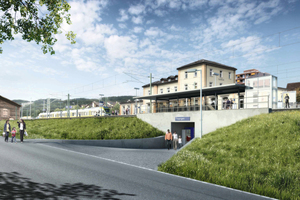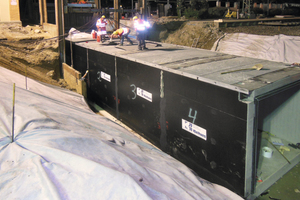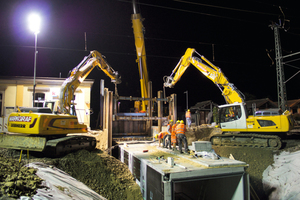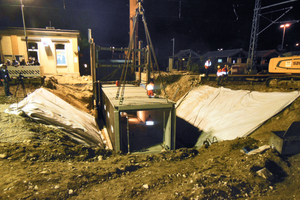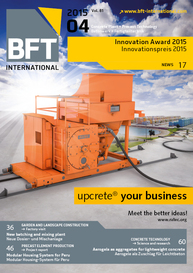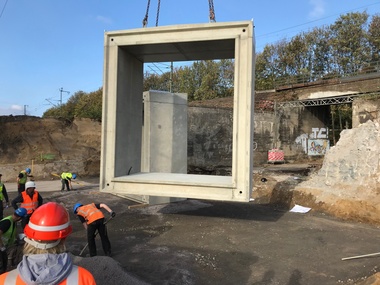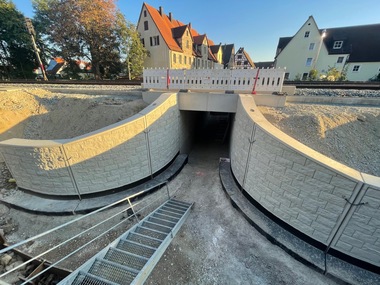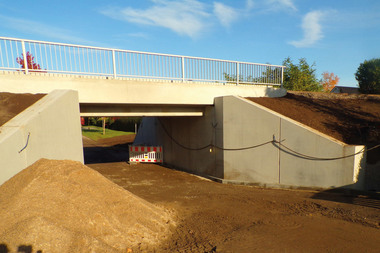Switzerland: Railroad underpass built in 52 hours
The station in the Swiss town of Thayngen is part of the railroad line from Zurich to Stuttgart. The European Union has classified this route as a Trans-European Network line or TEN line. In order to meet the associated requirements in the long run, the station situated in the canton of Schaffhausen will be refurbished until the end of 2015. The construction of a barrier-free pedestrian underpass with two elevators to the central platform is an important part of the rehabilitation measures. The planners in charge decided to use precast concrete elements for the construction of the underpass in order to keep the disruptions of the rail operations to a minimum.
The new underpass will provide for safe and barrier-free access, thus connecting the town center and the industrial area in an even better way.
Just one track possession
The time frame which had to be kept was the crucial point in the overall construction project. “The underground construction, among others, was our part. So as to manage with just one track possession from the last train on Friday night to the first one on Monday morning, we quite consciously opted for precast concrete elements for the construction of the pedestrian underpass,” states René Borchert, site manager at the building contractor W. Markgraf GmbH & Co KG based in Bayreuth. Using this construction method spared the company the necessity of doing elaborated pit lining, building temporary bridges and casting of in-situ concrete. The time usually required for the construction of a temporary structure, could be used for the actual building structure.
Once the track bed had been removed and about 800 m³ of soil had been excavated, a mobile crane was used to position four precast elements weighing up to 47 tons in a depth of approx. 6 m below ground level. These precast elements are box segments, which were manufactured in the match casting method at the concrete block factory of Kleihues located in Emsbüren. After placing, they were bonded with epoxy resin, tensed against each other and installed in the final state firmly fixed. Two 13 m long strip foundations are used as the base of the tunnel.
“The great advantage of this construction method is the fact that immediately after the installation of the precast elements, we could start backfilling and placing the tracks again,” Borchert says. According to the site manager, this method cut the construction time in half in comparison to the conventional construction method. Moreover, the costs for the track possession could be kept down, which the client, DB Netz AG – accordance to the state treaty dated 1852, the line concerned is a German railroad line on Swiss territory – calculated at approx. €175 per delay minute if exceeding the track possession period causing train delays.
Excellent appearance,
high quality
Apart from the minor disruption of rail operations, this construction method has additional advantages: “Precast elements are manufactured in the factory under controlled conditions and subject to ongoing quality control,” Borchert states. “Therefore, they feature a significantly higher concrete quality in comparison to cast-in-situ construction. This has a very positive effect on the visual appearance.” The client decided to use fair-faced formwork with a simple tongued and grooved rough boarding surface for the underpass in Thayngen. In addition, this construction method requires far less working steps. In this way, the entire building project is simplified, thus reducing potential sources of error.
About 52 hours after the track possession, the progress of construction works already allowed the first train to cross the tunnel. The entire rehabilitation measure of the railroad station, with costs amounting to €9.5 million in total, is scheduled to be completed at the end of 2015. But it can already be taken for granted today that the reconstruction would have been much more expansive without the use of precast concrete elements.

